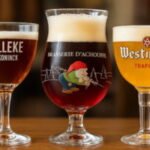 An Unexpected Love Affair with Belgian Beer
An Unexpected Love Affair with Belgian Beer
Before our Tauck river cruise through Belgium, I wouldn’t have even called myself a casual beer drinker. At home, I lean more toward sipping a fine whiskey — WhistlePig’s 10-Year Rye, to be exact — and rarely reach for a beer. But somewhere between Brussels and Bruges, the Belgian beers changed all of that.
It started with a Belgian beer tasting tour in Antwerp. One flavorful sip led to another, and before I knew it, I was hooked. The rich history, the distinct glassware, the variety of flavors — I found myself genuinely fascinated by the world of Belgian beer.
And here’s how you know it stuck: the minute I got home, I had Total Wine deliver me a supply of Duvel (my newfound favorite), and I ordered authentic Belgian beer glasses on Amazon. Consider me converted.
There’s a reason Belgium is considered one of the beer capitals of the world — with centuries of tradition, hundreds of breweries, and an unmatched devotion to flavor, craftsmanship, and identity.
A Brief History of Belgian Beer
Belgian brewing dates back to at least the 12th century, when monks in Trappist monasteries began producing beer as a safer alternative to water. Over the centuries, beer became ingrained in Belgian culture and evolved into an art form — one that values individuality, diversity, and, in many cases, a higher ABV.
Today, Belgium is home to over 400 breweries and styles ranging from crisp golden ales and rich dubbels to sour lambics and funky saisons. In fact, UNESCO added Belgian beer culture to its Intangible Cultural Heritage list in 2016. Simply put: it’s not just beer, it’s heritage in a glass.
Why Belgian Beer Wins Hearts
- Flavor Variety: Belgian beer isn’t about one flavor profile. It’s complex, creative, and bold — ranging from sweet to bitter, fruity to funky.
- Tradition: Many recipes date back hundreds of years, lovingly preserved by monks or family brewers.
- Glassware Ritual: Each beer has its own distinctive glass — a tradition that enhances aroma, foam, and the overall experience.
- Respect for Craft: Belgian brewers aren’t chasing trends; they’re perfecting their craft across generations.
The Beers We Loved Along the Way
Duvel
This golden strong ale is deceptively smooth for its high ABV. Light, floral, and slightly spicy, Duvel means “devil” in Flemish — and after a few sips, you understand why. It was hands down my favorite of the trip.
Leffe
A classic abbey-style beer, Leffe Blonde was smooth, slightly sweet, and easy to drink. Originally brewed by monks, it’s now one of Belgium’s most famous beers — and for good reason.
Viven Blonde
We discovered this refreshing blonde ale during our time in Bruges. Lightly hopped with citrus and herbal notes, Viven Blonde was clean, crisp, and slightly bitter — a modern take on a traditional Belgian style. It was a standout surprise and paired beautifully with a sunny afternoon in one of Bruges’ many charming squares.
Brugse Zot
Brewed in Bruges, this playful beer (“The Fool of Bruges”) had a soft bitterness and a hint of fruit. Perfect for sipping in a sunny square surrounded by medieval rooftops.
Westmalle Trappist
One of the original Trappist brews, Westmalle Tripel was bold, effervescent, and full of fruity esters. A true classic with monastery roots and a complex profile.
La Chouffe Cherry (Brasserie d’Achouffe)
Brewed by Brasserie d’Achouffe in the Ardennes, this cherry beer arrived in a whimsical glass featuring a mischievous gnome. It leaned sweeter than my usual taste, but what it lacked in dryness it made up for in potency — the high alcohol content packed a serious punch. A dessert-like finish to an already flavorful lineup.
De Koninck Bolleke
Served in its signature tulip glass, this Antwerp original was malty, caramelly, and very easy to enjoy. Locals call it simply “a Bolleke.” A great example of a classic Belgian pale ale.
Duvel 6.66%
A smoother, slightly sweeter version of the classic Duvel. Still flavorful, but more sessionable with lower alcohol. A great intro for those new to strong ales.
Hoegaarden
The classic Belgian witbier. Light, cloudy, and brewed with orange peel and coriander. Carol especially enjoyed this one during a casual café lunch in Brussels.
Travel Tip: If you’re headed to Belgium, consider adding a guided beer tasting or brewery visit to your itinerary. We did. It was fun, informative, and tasty!
If you’ve never explored Belgian beer beyond the occasional Stella Artois, I highly recommend diving into the true gems of the country’s beer heritage. Even for a former skeptic like me, it’s been a flavorful and fascinating ride.
And if you’d prefer to sample the real deal, give us a call and let’s book a Tauck river cruise for you! 
See More from Our Journey:
This experience was part of our recent Tauck river cruise through Belgium and Holland.
To see all of our daily highlights, reflections, and photos, visit our full cruise landing page here.
For more information about Tauck or a Tauck river cruise, please call Roaming Boomers Travel Services at (480) 550-1235 or use our convenient online information request (click here) and we’ll reach out to you.
If you enjoyed this article, sign up for our travel newsletter to keep abreast of our best travel tips, on-location reviews, exclusive travel offers, group travel events, and much more.

This article was written with the aid of Perplexity AI, or ChatGPT. Roaming Boomers Travel Services is an independent affiliate of Cadence and a Virtuoso® member. CST#201120-40
The post An Unexpected Love Affair with Belgian Beer appeared first on The Roaming Boomers













